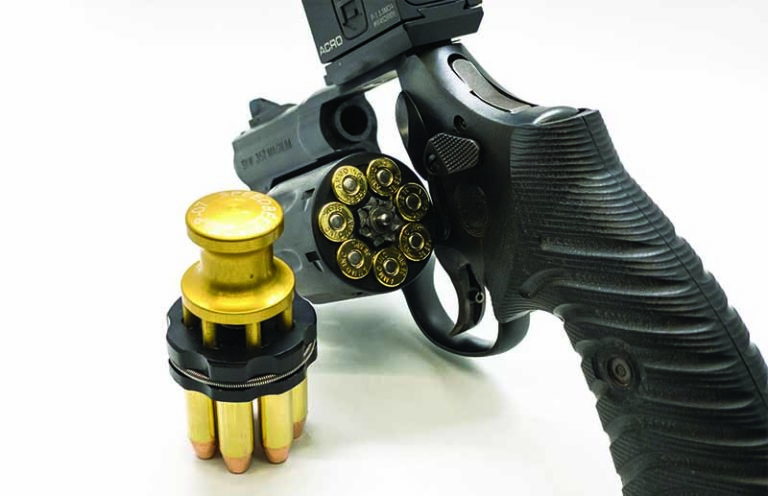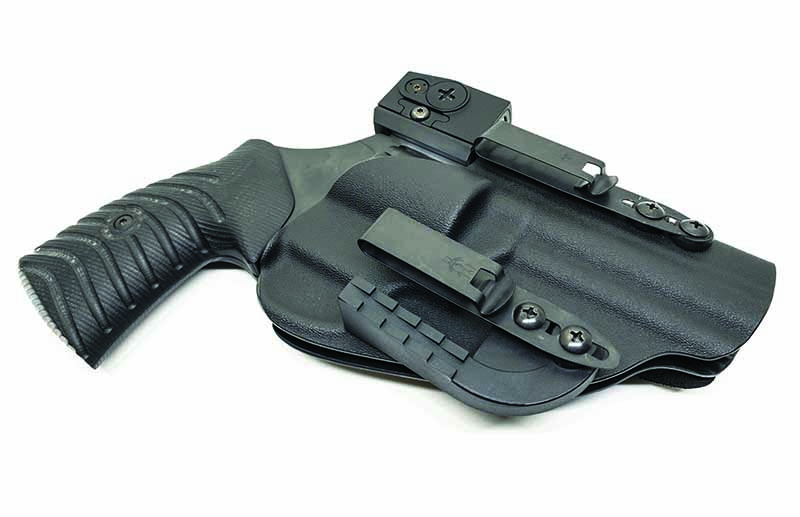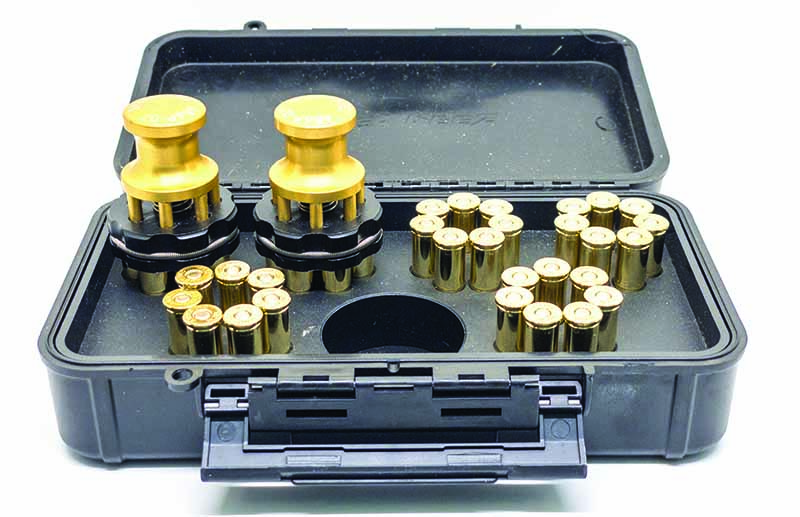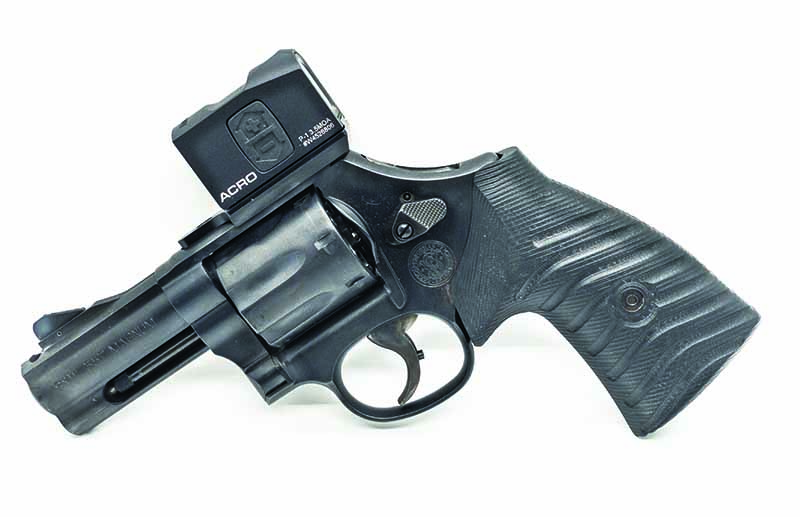
Defensively, can a gassed up Smith & Wesson Model 586 L-Comp keep up with a double-stack 9mm pistol?
How Has The Model 586 Been Modified:
- Aimpoint ACRO Red Dot on Apex Tactical Specialties mount
- Apex Evolution IV Hammer
- VZ Grips
- Minor trigger modifications
- JM Custom Kydex custom holster
Is it possible to run a wheelgun heads up against a modern semi-automatic pistol? That was the question I set out to answer after building what I’ve come to call “The Modern Fighting/Defensive Revolver.”
The Modern Fighting Revolver (MFR) builds around the idea of taking a revolver and giving it all the necessary upgrades to bring it into the 21st century, while still keeping the features intact that we love about wheelguns. To that end, the build theory was designed to emulate the popular “Roland Special” modified Glock. A Roland Special is usually a Glock 19 with a slide-mounted red-dot sight, weapon-mounted light and compensator.
To get as close to that design envelope as possible, the starting platform for the 21st-century revolver was a Smith & Wesson Model 586 L-Comp. The 586 L-Comp is an L-frame revolver, S&W’s larger mid-size frame with a 3-inch barrel. Technically, only 2.5 inches of the barrel are rifled, since the last half-inch is a single chamber compensator. Plus, it’s a seven-shot, which brings the capacity in line with someone carrying a 1911.
Honing The Model 586
There’s no good solution to mount a weapon light on the Smith & Wesson Model 586 L-Comp, so that was removed from the platform. That made the next solution how to mount an optic on the gun. Previous testing indicated that closed emitter optics were a better choice for a revolver, so the Aimpoint ACRO was the obvious choice. Thankfully, Apex Tactical Specialties makes a mount for S&W revolvers that replaces the rear sight and securely mounts an ACRO to the top strap.
The addition of an Apex Evolution IV hammer and some minor trigger modifications, plus a set of VZ grips completed the “build” portion of the task. But the question remained: How to test it? How do we answer the question of whether or not you really can run a revolver heads up against a semi-automatic pistol?

The clear answer is to subject it to the crucible of a high-round count class, specifically a class taught by Scott Jedlinski. Scott runs Modern Samurai Project and specializes in teaching shooting classes around the application of red-dot-equipped pistols. Scott was hosting a one-day clinic on appendix carry, followed by a two-day course co-taught with Jared Reston of Reston Group. Scott would cover daylight red-dot applications, and on day three, Jared would focus on low/no light shooting. The 586 L-Comp, now dubbed The MFR (Modern Fighting Revolver), would be the only wheelgun in attendance.
Filling in the Gaps
Once the test ground was selected, the last piece of the puzzle was support gear. This is all the stuff most people who don’t take a lot of classes or shoot matches don’t think about: holsters, magazines (for semi-autos), pouches, belts, etc.
The holster for the MFR was going to be a task in and of itself, because carrying that gun at the appendix position would require some clever engineering. Luckily, JM Custom Kydex was more than willing to provide that clever engineering. Tony designed an entirely custom holster based on his Wing Claw 2.0 design.
The top of the holster has a deep scallop cut to allow the ACRO and mount sufficient clearance, there’s a custom muzzle pad for the holster to keep the grip from rotating forward on the belt line, and the whole rig is secured to the belt with Discreet Carry Concepts Clips. It’s a considerable amount of holster and occupies a lot of belt space, but then again, it’s designed to hold a lot of gun. It works as advertised, because using the JMCK holster and a Mastermind Tactics Specialist belt, the revolver conceals easily under an untucked T-shirt.
The Smith & Wesson Model 586 L-Comp is cut for moon clips from the factory; however, I opted for speed loaders instead. There were a couple of reasons behind this. The first being that moon clips and .38 Special brass don’t always get along well. Clips are great for wheelguns chambered in semi-auto cartridges like 9mm, 10mm or 45 ACP, but I’ve had some unpleasant experiences with .38 Special moon clips. Plus, the backup gun to the 586 L-Comp is a 686+ that isn’t cut for clips, so the loading devices needed to work across all platforms.

Enter the folks at Speed Beez, who make one of the best speed loaders on the market. Their seven-shot loader is the gold standard for seven-shot speed loaders. They’re also not cheap, at nearly $40 a piece, but if you’re serious about running a wheelgun hard, they’re worth it. The speed loaders were an important component, because while the class doesn’t have any “on the clock” reloads, being able to keep pace with people shooting 15- to 20-shot 9mms means a lot of reloading. The Speed Beez are spring-loaded, so they’re a lot faster than a twist-knob-style loader. The last two bits of support gear were an OWB Blade-Tech holster for day two, and some loader pouches, also from Speed Beez.
The True Test
Gear sorted, it was time for the class. Forty-five minutes south of Miami is Homestead Training Center, the nicest outdoor training facility in South Florida: three solid days of training. Those three days of training also provided multiple opportunities to test the Modern Fighting Revolver heads up.
During the training day, Scott would have each student shoot the same scored standard, for example, a single shot from appendix, or three shots to the body and two to the head. He goes down the line and records scores, and the winner would receive a prize of some value. On top of that, at the end of days one and two, the class would have a man-on-man shoot-off. Two shooters enter the box, and the first one to hit a piece of steel at 25 yards wins. Selected shooters would also get a chance to take a crack at Scott’s challenging Black Belt standards, four strings of fire fired back-to-back for a score. Beating the time limits would earn someone a coveted Black Belt patch—as of this writing, there are only eight patch holders. Training day three also had scored standards, with the students shooting scored B8 targets at 25 yards.
The first question was whether running seven-round Smith & Wesson Model 586 L-Comp in class would cause me to lag behind the other students. That was answered quickly on day one with a resounding “no!” As long as I was aware of where I was in terms of round count, I could stage reloads between strings of fire with no issue. Keeping a Speed Beez loading block handy meant that if I needed to, I could recharge speed loaders in a hurry helped, but since training day one didn’t include any reloads “on the clock,” keeping pace was easy.
The next hurdle was a test of skill—the whole class would compete to see who could hit the A-zone of a target the fastest at seven yards. A 0.95 draw from the holster secured the win for me in this contest, and put the first tick mark in the win column for the Modern Fighting Revolver. The next win came at the end of class, where the MFR won the first head-to-head shoot-off of the weekend, defeating a student running a heavily customized Glock.

Day two brought more success for the upgraded defensive revolver. A win and a loss in class-wide competitions, but the gun’s record at 3 to 1 going into the final man-on-man 25-yard shoot-off. This was a battle, as the talent pool had deepened on day two, and the finale found the MFR squared off against Hilton Yam of 10-8 Performance. Hilton is a legendary 1911 gunsmith, former FBI SWAT operator and talented competition shooter. Winning against him would push the MFR to its limits of accuracy—which it did. The revolver brought home the win in the head-to-head shoot-off against a 1911 wizard.
The final training day involved scored B8s during the afternoon portions of the class. Once again, Hilton put a hard charge on, shooting all 90s or better. How did the wheelgun do? Six 10-shot strings resulted in scores of 92, 98, 95, 99, 94 and 96. Since Hilton also shot a 99, that one is a tie for the MFR. It wrapped up the scored portion of the class with four heads-up wins against semi-auto shooters, one loss and one draw. So if you want to run a wheelgun hard in a class heads-up against people with semi-autos, you absolutely can.
Defensive Revolver Shortcomings
Full disclosure: There was one area where the Smith & Wesson Model 586 L-Comp falls behind a quality semi-auto pistol, and that’s on any fast string of fire longer than three rounds. For example, the classic Bill Drill, where you draw and fire six shots as fast as possible. Because the revolver is entirely mechanically operated, the fastest split—or time in between shots—a shooter can realistically get is 0.22, maybe 0.20 on a really good day.
With a 1-second draw and five 0.22 splits, a “fast” Bill Drill is 2.10 seconds. Yes, that’s very fast, but a similarly talented shooter with a semi-auto pistol could shoot as fast as 0.18 splits and perform the same drill in 1.9 seconds. So, if pure speed is your goal, the revolver probably isn’t competitive.
The second caveat is that the revolver’s performance isn’t really about the gun at all—it’s about the shooter. If you’re a talented shooter, you’re going to be able to run a wheelgun heads up, because at the end of the day, it’s all just sights and triggers. If you’re relatively new or unskilled, it doesn’t matter what gun you buy or what doodads you hang on it—you can’t buy skill.

The final butcher’s bill for the Modern Fighting Revolver puts its price tag in line with other high-end defensive pistols. The Smith & Wesson Model 586 L-Comp alone starts at $1,100. Then, add in the following: $150 for the double-action-only conversion, $700 for the mount and optic and another $100 for the grips. That also assumes you’re competent enough as an armorer to install the new hammer and springs, so that you don’t have to pay a gunsmith to do it.
So, just the basic gun build costs more than $2,000, and that doesn’t include the Speed Beez speed loaders or holster. Once you add in all the accessories, you’re looking at near $2,500; and that’s a lot of money to build a revolver for a very specific purpose.
However, all that aside, the real question was whether or not a revolver can turn and burn in a class full of modified Glocks and double-stack 9mm pistols. The answer to that?
Absolutely.
For more information on the Smith & Model 586 L-Comp, please visit smith-wesson.com.
Editor's Note: This article originally appeared in the February 2021 issue of Gun Digest the Magazine.
Raise Your Smith & Wesson IQ:
- Smith & Wesson Performance Center
- M&P9 Shield EZ
- Model 648
- Model 442
- Model 929
- M&P380 Shield EZ
- M&P10 Sport
- Model 629
- SW22 Victory
- M&P45 Shield
- Model 629 Performance Center
- M&P15
- M&P R8
- Schofield
- Smith & Wesson .357 Magnum Revolver
- Triple-Lock

Next Step: Get your FREE Printable Target Pack
Enhance your shooting precision with our 62 MOA Targets, perfect for rifles and handguns. Crafted in collaboration with Storm Tactical for accuracy and versatility.
Subscribe to the Gun Digest email newsletter and get your downloadable target pack sent straight to your inbox. Stay updated with the latest firearms info in the industry.

![Best Concealed Carry Guns In 2025 [Field Tested] Wilson Combat EDC X9S 1](https://gundigest.com/wp-content/uploads/Wilson-Combat-EDC-X9S-1-324x160.jpg)


![Best 9mm Carbine: Affordable PCCs [Tested] Ruger Carbine Shooting](https://gundigest.com/wp-content/uploads/Ruger-Carbine-Shooting-100x70.jpg)
![Best AR-15: Top Options Available Today [Field Tested] Harrington and Richardson PSA XM177E2 feature](https://gundigest.com/wp-content/uploads/Harrington-and-Richardson-PSA-XM177E2-feature-100x70.jpg)
